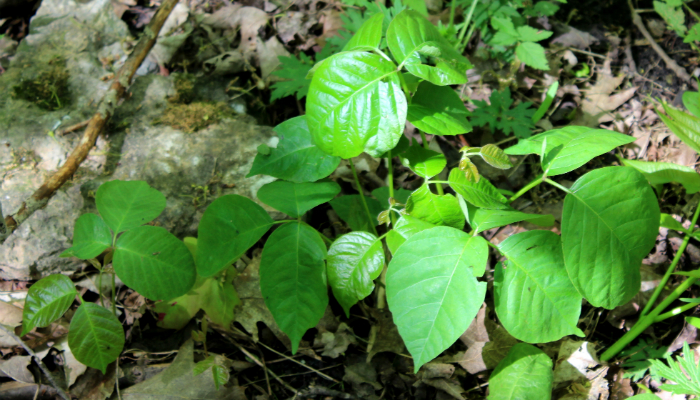Are You Ready for Poison Ivy Season?

For me it is not a question of “if” but a question of “when.” When will I get my first poison ivy rash of 2017? Did I already have it this winter when I was clearing brush? I think I did, but I was only a #2 on the skin irritation scale. It doesn’t matter if active photosynthesis is taking place. The oil called urushiol is always there, waiting for a sensitive host to feel its wrath!
I know a man that inoculates himself with poison ivy every spring, he eats small poison ivy leaves in some sort of Russian roulette salad. I even tried it one year, completely flabbergasting my coworkers at the Amana Golf Course. Did it work? I didn’t have a major outbreak like I did the year before, although I may have become hypervigilant about spotting and avoiding poison ivy. Try this at your own risk.
Ingesting poison ivy may not work for you or anyone for that matter, but you can be absolutely assured inhalation of smoke originating from poison ivy can be detrimental to your health. It is not recommended to burn poison ivy under any circumstances.
Be sure you cover your skin when working in areas where you suspect poison ivy populations exist (outdoors). If your dog is a free-range animal on the acreage like my Gunther, you are going to have a bad time (he is a poison ivy carrier). Good news, you cannot get poison ivy from someone else’s blisters and your blisters do not spread from the pioneer blisters.
Like the pioneers spreading across this land, so has poison Ivy. It has survived many human’s efforts to force it into extinction. It goes by the names Rhus radicans, Rhus toxicodendron, and Toxicodendron radicans. “Leaves of three let it be!” they said. Until you look around for a while and notice all of the plants with three leaves. I always look for leaves of three with some serrations and some reddish color along the veins. The plants can be on the ground like a toxic blanket in an apple orchard strategically waiting for you to pick up that fresh apple that just fell to the ground. Or it can run all the way up an old oak tree, strategically setting a diabolical branch right at eye level. Speaking of oak, there is no poison oak here in Iowa. Poison ivy, Queen Anne’s lace (aka wild carrot or birds nest plant), and wild parsnips are the usual suspects when it comes to rashes. At least for me.
Getting rid of poison ivy in your garden or on your land can be done with a certain level of danger. You can cut the vines down from the trees or uproot them. In my opinion, you are better off cutting a notch out of the vine, dabbing some triclopyr on the cut stump and leaving it on the tree. Use some tree-safe spray paint to mark the vine for others to see how much you care for them. If you have a blanket of plants on the ground, you might consider spraying them with some glyphosate. Consult your local garden center or resident expert, because poison ivy often cohabitates with desirable plants, making it likely collateral damage will occur. Don’t like the use of chemical? You can either try the salad or get to removing as much of the plant material as possible with your version of a hazmat suit on.
Once you treat the poison ivy, make sure you launder all of the clothing and gloves you wore. Get them in the machine, turn it on, and run to the sink to slather yourself with Dawn dish soap or Tecnu cream or gel. I am not being paid for all of this advertising.
Don’t let the threat of poison ivy keep you from enjoying the outdoors, and being a steward of your little slice of heaven. Take the reasonable precautions to protect yourself and the ones you love. If you get a rash that will affect your daily life go see a doctor. If you get a mild poison ivy rash that doesn’t require cortisone or steroids, make sure you get your pink calamine lotion out and wear it proudly!
Poison ivy photo by Arthur Chapman


